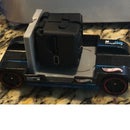Introduction: Garden Bridge - Updated
I threw this bridge together in an evening to get rid of some scrap wood left over from construction on the house. The lights were new as were some of the screws. The majority of it was made from 2x12 yellow pine, with the deck made from cedar fencing. The solar lights are from Harbor Freight, and set into 11/16" holes in the posts.
The DXF file was set up for the length of boards I had, but I'm happy to send them if interested. This one was a gift for my neighbor.
Here is the updated version. It appears I can't change it to a Step-By-Step, So everything will have to be in this body. Here goes:
Step 1: Gather Materials and Tools
Item 66249 from Harbor Frieght - Solar Light Set http://www.harborfreight.com/10-piece-stainless-steel-solar-light-set-66249.html
2 x 12 twice the length of finished bridge
3-4 Cedar fence boards
Landscaping timber or other PT 4x4
Brass Screws 1" long (approximately 60)
2-1/2" screws for blocking/anchoring rails
Tools:
Bandsaw or Jig Saw
Table Saw
11/16" drill bit (for these lights)
Belt Sander
Step 2: Design Bridge
I used CAD to design both bridges and plotted them at work, but using this Instructable, you won't need to.
The trick is to use as much of the 2 x 12 as possible for the arch. I nested two curved bottom rails on one 2 x 12 piece (cut to 36") and the top railing and last bottom rail on the other. Make sure you leave yourself at least 3/4"-1" of room for wavy cuts or undersized boards (2 x 12 actually runs 1-1/2" x 11-1/2").
Step 3: Cut parts
I cut the curved parts with a bandsaw, and the straight parts on a table saw. The posts are simply 1-1/2" x 1-1/2". I found there was a bow in the landscaping timber I used and had to flatten the bottom on one side. I found it helpful to cut one curved side off to set against the notch I cut in the rails. I also lowered the blade to about 1/8" and cut a decorative notch around each post 1-1/2" from the top, just to break up the look. I ripped the top rail to approximately 5/8". This left me with two clean parallel sides to work with. I also cut a 45 on the bottom of each post, just for aesthetics.
Step 4: Assemble skeleton
Attach the blocking (boards between bottom rails) and the bottom rails to the base. This step isn't completely necessary if you are only using the bridge for decoration, but the material on the inside of the curves was utilized for this, so no additional wood was wasted, and the bridge is much sturdier. Build it like it will be used, just in case.
Step 5: Test fit and attach deck boards
I cut all of the boards for maximum yield instead of measuring what I needed. And so had to find another cedar board to use of the top center boards because the smaller boards would have created an unsightly gap. Make sure you use the boards with the growth rings facing up, and predrill all holes. The cedar is screwed down so close to the edge, it will split if you are not careful.
Step 6: Drill post mortises and light holes
Use a tape measure or square to find the center of each post. I used an old paddle bit to drill the holes, but an auger bit would have worked better. Next measure down from the top by about 2" and drill two 3/8" holes to create the mortises. Remember that there will be a left/right on each side (don't worry about angling the holes). The center mortises should go all the was through.
Step 7: Attach Center Posts, Cut rail tenons
I found it easiest to attach the center post in it's final position (with screws from the back), before cutting the railing and tenons. For the tenons, I used the belt sander. If your holes are not perfectly aligned, it allows you to cut more or less off each edge.
Step 8: Attach the remaining posts
For each of the remaining posts, hold them in place with a clamp to get the fit of the tenon correct. Then, glue and tack the railing in place through the tenon. Use screws from the back to secure the posts.
Step 9: Add lights and admire
The second bridge is progressing much better than the first. I found a buyer before I starting building it. It has cleared out my remaining 2 x 12, and leftover fence boards from my gate construction. I have tried to write in all of the pitfalls and mistakes I made so you won't make the same. I can bounce up and down on the bridge without the slightest deflection. The bottom rails are 3-1/2" in width, which means it should remain sturdy enough to walk on for a LONG time.
The scrap wood from this project is probably the least I have ever produced. There was literally 1" left over from each fence board(the dog ears), and I used the cut outs from the curves to produce the blocking and posts. You really can build it will three fence boards, a 2 x 12 and a pressure treated post.

Participated in the
Gardening Contest

Participated in the
Instructables Green Design Contest













